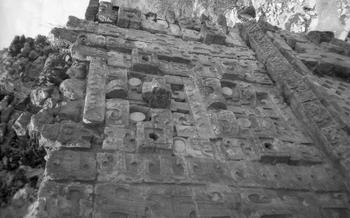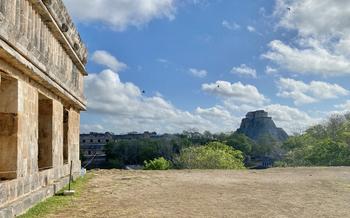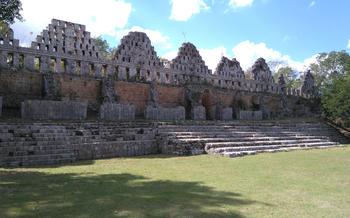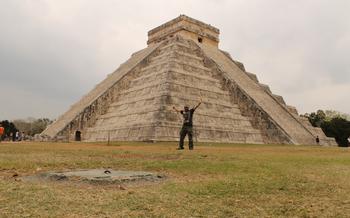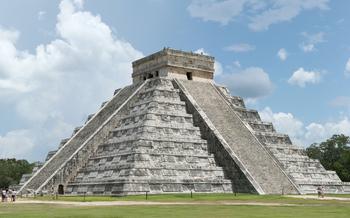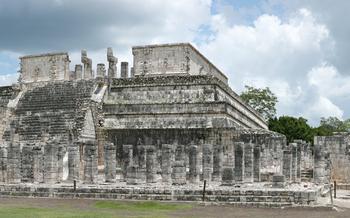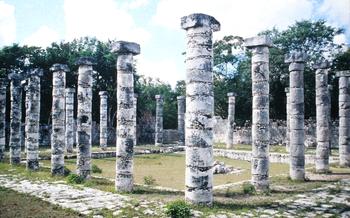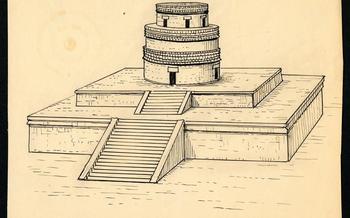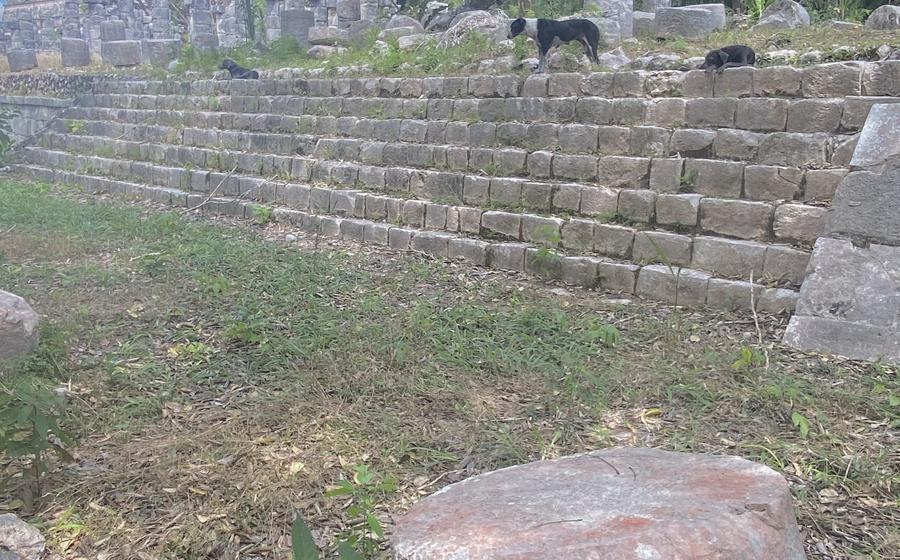
San Miguelito Archaeological Site
- Historical significance of the site
- A Glimpse into the Past: Exploring the Ancient Maya City
- The Ball Court: A Stage for Ritualistic Games
- The Temple of the Initial Series: A Window into Maya Chronology
- The Temple of the Masks: Unveiling the Faces of Maya Deities
- The Temple of the Warriors: Guardians of the Maya Realm
- The Nunnery Quadrangle: A Space for Sacred Women
- The Great Plaza: A Gathering Place for Rituals and Ceremonies
- The Stelae Field: Voices from the Past
- The Sacrificial Altar: A Place of Reverence and Offerings
- Insider Tip: Unveiling the Hidden Treasures of San Miguelito
- The Residential Areas: A Glimpse into Maya Domestic Life
Historical significance of the site
In the heart of the Yucatan Peninsula, nestled amidst the lush vegetation, lies the ancient Maya city of San Miguelito. This archaeological site holds a profound historical significance, serving as a testament to the ingenuity and cultural richness of the Maya civilization. Situated approximately 30 kilometers southeast of the renowned Chichen Itza, San Miguelito offers a unique glimpse into the lives, rituals, and beliefs of this enigmatic people. Its strategic location along ancient trade routes facilitated thriving commercial exchanges and cultural interactions. Archaeological discoveries continue to shed light on the city's pivotal role in the Maya world, revealing its political, economic, and religious importance. Excavations have unearthed a wealth of artifacts, including intricate sculptures, ceramic vessels, and hieroglyphic inscriptions, providing valuable insights into the daily life, social structure, and religious practices of the Maya who inhabited this sacred city. Ongoing research at San Miguelito contributes to our understanding of the Maya civilization's complex social dynamics, technological advancements, and cultural legacy.
A Glimpse into the Past: Exploring the Ancient Maya City
San Miguelito, a once-vibrant Maya city, played a significant role in the Maya civilization. As an important regional center, it served as a hub for trade, agriculture, and religious activities. The site's strategic location near water sources and fertile land contributed to its prosperity.
Architectural Marvels and Unique Features
San Miguelito showcases remarkable architectural achievements, reflecting the Maya's advanced engineering and construction skills. One of its most notable features is the impressive stepped pyramid, which served as a temple and a platform for religious ceremonies. The city also boasts several other temples, each dedicated to different deities and adorned with intricate carvings and sculptures.
Insights into the Daily Life and Culture of the Maya
A visit to San Miguelito offers a glimpse into the daily life and culture of the ancient Maya. Archaeologists have unearthed numerous artifacts, including ceramics, tools, and jewelry, providing insights into their domestic life, economic activities, and artistic traditions. The site's well-preserved residential areas reveal the Maya's social organization and family structures.
The Ball Court: A Stage for Ritualistic Games
Significance of the Ball Game in Maya Society
For the ancient Maya, the ball game was more than just a sport - it held deep cultural and religious significance. It was believed to be a reenactment of the mythical struggle between the Hero Twins and the Lords of the Underworld, symbolizing the cyclical nature of life and death. The outcome of the game was seen as a portent of future events, and it played a crucial role in Maya political and religious rituals.
The Design and Layout of the Ball Court at San Miguelito
The ball court at San Miguelito is one of the largest and best-preserved in the Maya world. It measures approximately 150 feet long and 45 feet wide, with two sloping side walls and two end zones. The court is divided in half by a central line, and each side has a sloping platform with a large stone ring attached to it. These rings were used as targets for the ball, and the team that scored the most points by hitting the ball through the ring was declared the winner.
Symbolism and Mythology Associated with the Ball Game
The ball game was closely associated with Maya mythology and cosmology. The ball itself was seen as a representation of the sun, and the court was believed to be a microcosm of the universe. The two teams represented the forces of light and darkness, and the game was seen as a way to maintain the balance between these forces. The players wore protective gear that resembled the attire of Maya gods, and the game was often accompanied by music, dance, and elaborate rituals.
The Temple of the Initial Series: A Window into Maya Chronology
At the heart of San Miguelito, the Temple of the Initial Series stands as a testament to the Maya's advanced understanding of time and astronomy. Its name derives from the intricate inscriptions and hieroglyphs that adorn its facade, providing valuable insights into Maya calendrics and astronomical knowledge. Deciphering these inscriptions has allowed researchers to pinpoint the exact date of the temple's construction, revealing its significance as a timekeeping and ceremonial center.
The temple's intricate carvings depict various astronomical events, including the solstices and equinoxes. These celestial phenomena held deep religious and symbolic meaning for the Maya, who believed that they influenced the cycles of life, agriculture, and the cosmos. By studying the alignments of the temple's windows and doorways, archaeologists have gained a deeper understanding of the Maya's sophisticated astronomical observations and their ability to predict celestial events with remarkable accuracy.
The Initial Series glyphs on the temple's facade also provide valuable information about Maya history and chronology. These inscriptions record the names and dates of Maya rulers, as well as significant events in their reigns. By piecing together these historical fragments, researchers have been able to construct a detailed timeline of Maya civilization and gain insights into the political and cultural dynamics of the region.
The Temple of the Masks: Unveiling the Faces of Maya Deities
The Temple of the Masks, a captivating structure within the San Miguelito Archaeological Site, stands as a testament to the Maya civilization's profound religious beliefs and artistic prowess. The temple's exterior is adorned with an array of masks, each representing a different Maya deity. These masks, carved with intricate detail, provide a glimpse into the complex pantheon of Maya gods and goddesses.
The masks on the Temple of the Masks are not merely decorative elements; they hold deep symbolic meaning and served a significant role in Maya religious practices. Each deity represented by a mask had specific attributes, powers, and associations. The masks were believed to be imbued with the essence of the deities they depicted, serving as intermediaries between the mortal world and the divine realm.
During religious ceremonies and rituals, Maya priests and shamans would wear masks representing specific deities. By doing so, they sought to channel the power and guidance of those deities, invoking their presence and blessings. The Temple of the Masks thus served as a sacred space where Maya devotees could connect with the divine and seek spiritual guidance.
The Temple of the Warriors: Guardians of the Maya Realm
Amidst the architectural wonders of San Miguelito, the Temple of the Warriors stands as a testament to the power and prowess of the Maya civilization. This imposing structure, situated on the western side of the Great Plaza, is a captivating sight with its towering height and intricate carvings.
The temple's design is characterized by a series of terraces, each adorned with bas-reliefs depicting fierce warriors engaged in battle. These elaborate carvings showcase the Maya's exceptional craftsmanship and provide a glimpse into the military aspects of their society. The warriors are depicted in dynamic poses, brandishing spears, shields, and other weapons, symbolizing their strength and courage in defending their realm.
Beyond its aesthetic beauty, the Temple of the Warriors holds significant symbolic and religious meaning. The Maya believed that warriors played a crucial role in protecting their communities and ensuring their prosperity. The temple served as a sacred space where rituals and ceremonies were performed to honor and appease the warrior deities. Offerings were made to seek their protection and guidance in times of conflict.
The temple's prominent location within the site further emphasizes its importance. Facing the Great Plaza, the central gathering place for rituals and ceremonies, the Temple of the Warriors served as a constant reminder of the Maya's military might and their unwavering devotion to their deities.
The Nunnery Quadrangle: A Space for Sacred Women
Amidst the grandeur of San Miguelito, the Nunnery Quadrangle stands as a testament to the significant role women played in Maya society. This enclosed space, set apart from the rest of the city, served as a sanctuary for holy women and priestesses who dedicated their lives to religious rituals and ceremonies. The quadrangle's architecture reflects its sacred purpose, with intricate carvings and iconography adorning its walls and doorways.
Within the quadrangle, women engaged in various religious practices, including weaving sacred textiles, preparing offerings for ceremonies, and performing rituals to honor Maya deities. The presence of residential chambers suggests that these women may have lived within the quadrangle, forming a close-knit community dedicated to their spiritual duties.
The Nunnery Quadrangle offers a glimpse into the important role women held in Maya society, transcending their traditional domestic roles to become influential figures in religious and spiritual matters. Their contributions to Maya culture and their dedication to their faith are evident in the sacred atmosphere of this secluded sanctuary.
The Great Plaza: A Gathering Place for Rituals and Ceremonies
The Great Plaza, the heart of the ancient Maya city of San Miguelito, served as a central gathering place for a variety of rituals, ceremonies, and public events. Its expansive open space, surrounded by towering temples, stelae, and other monumental structures, provided a stage for religious processions, dances, and other performances.
The plaza's central location and its connection to various temples and structures suggest that it played a crucial role in the city's religious and civic life. Important ceremonies, such as those related to the Maya calendar, the accession of new rulers, or the celebration of victories, were likely held here.
Beyond religious rituals, the Great Plaza also served as a venue for public gatherings, markets, and other social events. The Maya placed great importance on community and collective activities, and the plaza provided a space for people to come together, exchange goods, share stories, and strengthen their communal bonds.
The Stelae Field: Voices from the Past
Within the archaeological site of San Miguelito, the stelae field stands as a testament to the Maya's rich history and cultural expressions. These carved stone monuments, intricately inscribed with glyphs and imagery, serve as a window into the past, providing invaluable insights into Maya chronology, genealogy, and political power.
The stelae, often arranged in rows or clusters, feature a variety of subjects, including rulers, deities, and historical events. Their inscriptions, meticulously carved in the Maya script, document important dates, lineage information, and significant achievements of Maya leaders. Through the decipherment of these glyphs, archaeologists have been able to piece together the intricate tapestry of Maya history, shedding light on the rise and fall of dynasties, alliances, and conflicts.
Beyond their historical significance, the stelae also offer a glimpse into the Maya's intricate belief system. Many stelae depict scenes of rituals, ceremonies, and interactions with deities, providing valuable insights into Maya religious practices and mythology. The intricate carvings showcase the Maya's artistic prowess and their deep connection to the divine realm.
Exploring the stelae field at San Miguelito is a journey through time, allowing visitors to connect with the voices of the past and gain a deeper understanding of the Maya civilization's rich cultural heritage.
The Sacrificial Altar: A Place of Reverence and Offerings
At the heart of the San Miguelito archaeological site lies a sacred and somber monument: the Sacrificial Altar. This imposing structure holds profound significance in understanding Maya religious practices and rituals. Constructed from massive stone blocks, the altar exudes an aura of reverence and awe. Its elevated platform, adorned with intricate carvings and symbolic motifs, served as a stage for solemn ceremonies and offerings to the gods.
Archaeological evidence suggests that the altar was a focal point for sacrificial rituals, a practice deeply embedded in Maya culture. Animal sacrifices, particularly of deer and turkeys, were common, as were human sacrifices reserved for significant events or to appease the gods in times of crisis. The altar's design facilitated the draining of blood and other offerings, which were believed to nourish and strengthen the Maya deities.
The discovery of sacrificial artifacts, such as finely crafted obsidian knives and ceramic vessels, provides further insight into the rituals performed at the altar. These objects, imbued with sacred power, were meticulously prepared and used to execute the sacrifices with precision and reverence. The altar's proximity to other important structures, including temples and plazas, underscores its central role in the religious life of the Maya people.
Insider Tip: Unveiling the Hidden Treasures of San Miguelito
Beyond the main attractions of San Miguelito, there are hidden gems waiting to be discovered by the curious and adventurous traveler. Explore the lesser-known corners of the site, where you might stumble upon ancient trails that once connected different parts of the city. Keep an eye out for intricate carvings and inscriptions on overlooked structures, revealing glimpses into the lives and beliefs of the Maya.
For photography enthusiasts, the soft golden light of dawn or dusk casts a magical glow on the ruins, creating stunning opportunities for capturing the site's grandeur. Tripod and telephoto lenses are recommended to capture detailed shots of distant structures and wildlife.
History buffs can delve deeper into the mysteries of San Miguelito by visiting the on-site museum, which houses a collection of artifacts and provides insightful information about the site's history and significance. Guided tours led by knowledgeable experts offer a wealth of knowledge and anecdotes, bringing the ancient Maya civilization to life.
The Residential Areas: A Glimpse into Maya Domestic Life
Venture beyond the grand temples and plazas of San Miguelito to discover the residential areas, where the ancient Maya people lived and thrived. These areas offer a glimpse into their daily lives, social structure, and domestic activities. Carefully planned and organized, the residential areas showcase the Maya's ingenuity and adaptation to their environment.
Archaeological excavations have revealed various types of dwellings, from simple huts to more elaborate structures with multiple rooms and elevated platforms. Each household likely consisted of an extended family or clan, with strong bonds and a shared sense of community.
Within the residential areas, archaeologists have unearthed a wealth of artifacts that provide insights into Maya domestic life. These include cooking utensils, ceramic vessels, stone tools, and personal ornaments, each telling a story of the people who once called San Miguelito home.
The layout of the residential areas reveals a deep understanding of spatial organization. Streets and alleyways crisscrossed the neighborhoods, connecting homes and public spaces. Maya families cultivated small gardens near their dwellings, growing crops such as maize, beans, and squash to supplement their diet.
Exploring the residential areas of San Miguelito is like stepping back in time, offering a rare glimpse into the daily lives of the ancient Maya people. Here, you can imagine the hustle and bustle of everyday life, the sounds of laughter and conversation, and the sense of community that bound the residents together.
